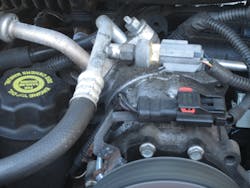One morning, when I was busy typing away for VehicleServicePros.com, a couple representatives from a large company came into the office. They were at my place to meet with automotive trainer and consultant G "Jerry" Truglia, my father, to get his opinions on a prototype thermal imaging tool they are developing.
The tool was very impressive and I cannot get into any details about it, but in the middle of their conversation they brought up a competing visual IR thermomemter that I had experience using. I interrupted, "That tool is really good for the money, plus it has a full color screen. Comparable thermal imagers are more expensive, even when they have black and white screens."
Then one of the reps said, "Well, it's not really a thermal imager. It's just a real fancy spot thermometer."
At first I thought to myself, "Huh? It looks like a thermal imager. In fact, it has very clear resolution on its screen."
Now, I'm not a tool engineer, so the following explanation might be completely inaccurate. However, as far as I know, there is one difference between a thermal imager and a "visual IR thermometer."
A thermal imager actually shows the heat signature that you are looking at while a thermal IR thermometer only sees temperatures as a number. The way in which a thermal IR thermometer compensates for this is that it uses a video camera and a really advanced temperature gun that can see not just temperature in one spot, but temperatures in dozens of spots. Then, software in the tool overlays the temperature information over the video image making the image look like that of a thermal imager, but in some ways even crisper and easier to see (because it is based upon an actual video image of what is going on.)
In fact, a visual IR thermometer, like the Fluke VT02, emulates a thermal imager so consistently that it can even pick up a heat signature of a palm print on your desk several seconds after you removed your hand.
So, in my opinion, whether you have a visual IR thermometer or a thermal imager, for our purposes in auto repair it really doesn't matter. Having either one helps you quickly spot seized calipers, cooling system and A/C blockages, misfires on diesel engines, parasitic draws and much more. However, the technological difference between IR thermometers and thermal imagers can become relevant when we run into problems we don't anticipate. One day, we'll just have to find out!

